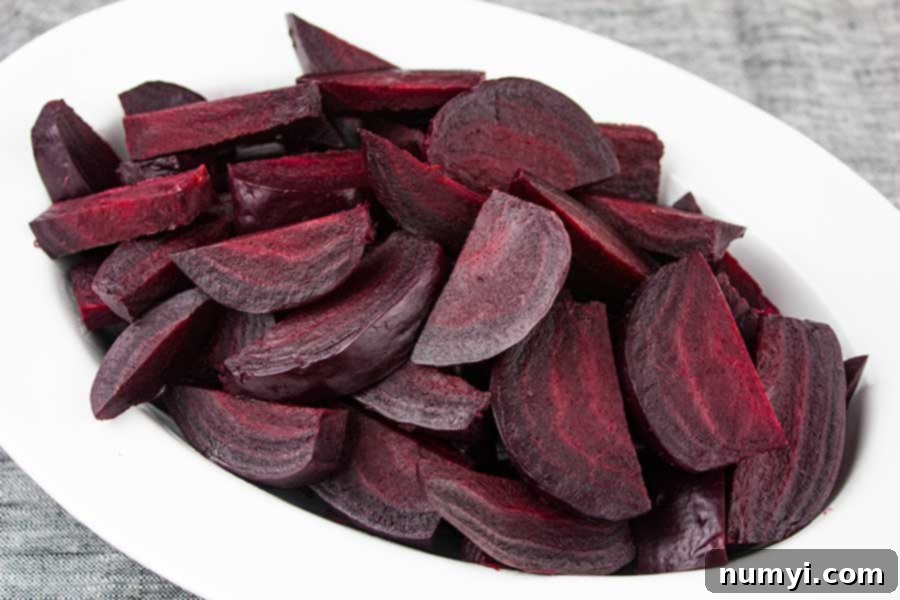Easy Ninja Foodi Pressure Cooker Fresh Beets: Tender & Flavorful in Under 30 Minutes
Discover the simplest way to cook incredibly fresh, tender, and flavorful beets with your Ninja Foodi pressure cooker! Say goodbye to tedious stovetop boiling and hello to perfectly cooked beets in under 30 minutes. This recipe will transform your perception of fresh beets, making them an indispensable, healthy, and vibrant side dish for any meal.

I must confess, for a long time, fresh beets felt intimidating. My family and I enjoyed beets, but our go-to was always the canned variety. That was until I decided to try cooking fresh beets in my pressure cooker. The transformation was astonishing, and honestly, there’s no going back.
The difference in taste and texture between pressure cooker beets and canned beets is simply incomparable. Freshly cooked beets boast a rich, earthy sweetness and a delightfully tender consistency that canned versions can’t match. My family immediately noticed the superior quality, and now, this method is our absolute favorite. It’s not just easier; it’s genuinely better.
Pressure Cooking Fresh Beets: Ninja Foodi or Instant Pot – The Choice is Yours!
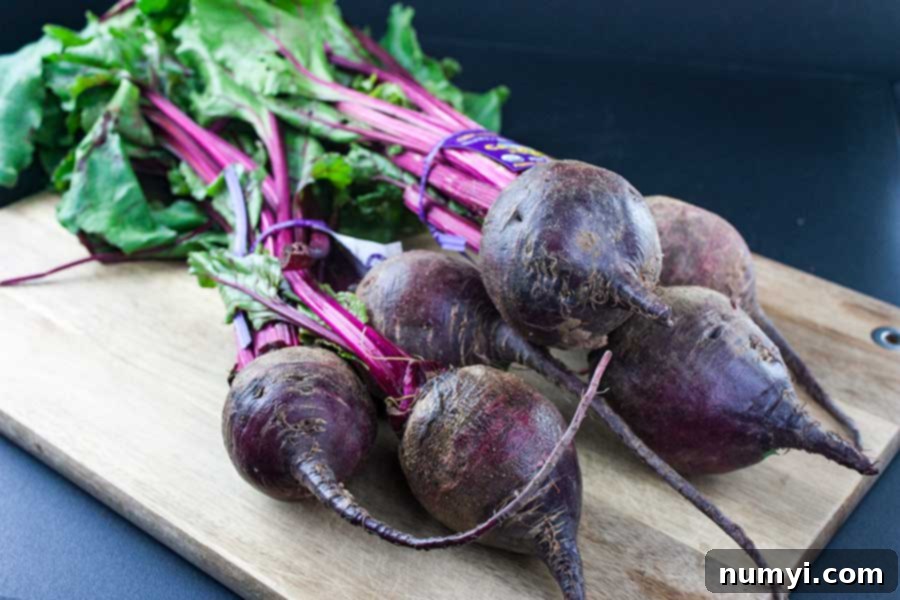
Don’t Sweat The Recipe is supported by its readers. We may earn a commission if you purchase through a link on our site. Learn more.
The beauty of this method is that it works seamlessly with both the Ninja Foodi and the Instant Pot. Whether you own a multi-cooker like the Ninja Foodi with its TenderCrisp technology or a classic Instant Pot, you can achieve perfectly cooked beets with the same reliable results and cooking times. Just follow these simple steps to enjoy this vibrant, healthy side dish.
I recently found these gorgeous beets on sale at my local supermarket for an unbelievable price, and it was the perfect excuse to try cooking them fresh. It turned out to be one of the best kitchen decisions I’ve made!
For an even more appealing presentation, consider using a mixture of red beets and golden beets. Their contrasting colors will create a visually stunning side dish that’s sure to impress.
Unlocking the Power of Beets: Incredible Health Benefits
Beets are not just delicious; they are a nutritional powerhouse, packed with essential vitamins and minerals that contribute to overall well-being. Incorporating fresh beets into your diet is a fantastic way to boost your health.
Here are some of the remarkable health benefits of beets:
- Rich in Nutrients: Beets are an excellent source of potassium, betaine, magnesium, folate (Vitamin B9), and Vitamin C. These nutrients play crucial roles in various bodily functions, from nerve and muscle function to DNA synthesis and immune support.
- Digestive Health: The high fiber content in beets promotes a healthy digestive system, aiding in regular bowel movements and preventing constipation. Fiber is also essential for maintaining a healthy gut microbiome.
- Anti-Inflammatory Properties: Beets contain betalains, potent antioxidants and anti-inflammatory compounds responsible for their vibrant color. These compounds may help reduce inflammation throughout the body, offering protection against various chronic diseases.
- Blood Pressure Regulation: Beets are rich in nitrates, which the body converts into nitric oxide. Nitric oxide helps to relax and dilate blood vessels, leading to improved blood flow and a significant reduction in blood pressure. This makes beets a valuable food for cardiovascular health.
- Boosts Stamina: The nitrates in beets have also been shown to improve athletic performance by enhancing oxygen utilization and increasing stamina, making them a favorite among athletes.
- Brain Health: Improved blood flow from the nitrates can also benefit brain function, potentially enhancing cognitive performance and reducing the risk of age-related cognitive decline.
- Detoxification Support: Beets support liver function, which is critical for the body’s natural detoxification processes. Betaine, in particular, helps protect liver cells.
With such a rich profile of health benefits, these vibrant root vegetables are truly a superfood worth adding to your plate.
Does Beet Size Affect Pressure Cooker Cooking Times?
Yes, the size of your fresh beets absolutely matters when it comes to determining the precise pressure cooking time. While the recipe below suggests 30 minutes for medium-sized beets (approximately 3 inches in diameter), smaller or larger beets will require adjustments.
For optimal and even cooking, it’s always best to select beets that are similar in size. If your bunch includes a variety of sizes, try to group them by diameter. If necessary, you can cut larger beets into halves or quarters to match the size of smaller ones, ensuring they all cook thoroughly and consistently. Refer to the notes in the recipe card below for a detailed guide on cooking minutes based on beet size.
How to Cook Fresh Beets in an Electric Pressure Cooker (Ninja Foodi or Instant Pot)
Cooking fresh beets in an electric pressure cooker like the Ninja Foodi or Instant Pot simplifies the process dramatically, yielding perfectly tender results with minimal effort. Here’s how to do it:
Step-by-Step Preparation:
- Trim the Beets: Start by trimming the beets. Leave about 1/2-inch of the stem and roots intact. This crucial step helps prevent the beets from “bleeding” too much of their vibrant red color into the cooking water, and it also makes the peeling process much easier after they’re cooked.
- Save the Greens: Don’t discard those beautiful beet greens! They are incredibly nutritious and delicious. I have a fantastic recipe that shows you how to cook fresh beet greens in your Ninja Foodi in less than 5 minutes. It’s a perfect way to minimize waste and enjoy another healthy part of the beet plant.
- Wash Thoroughly: Give your beets a good scrub under running water to remove any dirt or soil. There’s no need to peel them at this stage. In fact, waiting until after cooking makes the skin practically slip off, saving you time and effort.
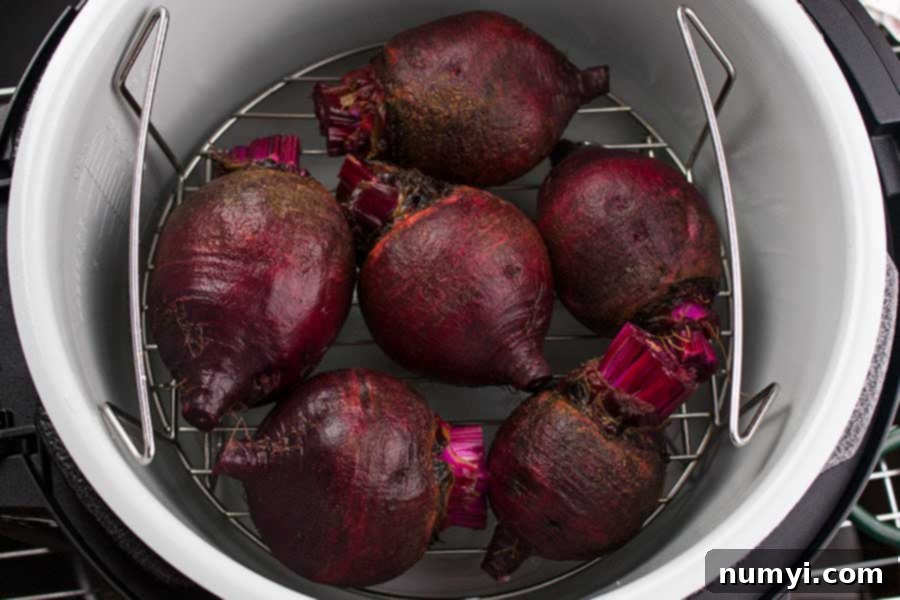
Pressure Cooking Instructions:
- Set Up Your Pressure Cooker: Place the steaming rack (or trivet) at the bottom of your Ninja Foodi or Instant Pot inner pot.
- Add Water: Pour 1 1/2 cups of water into the pot. This water creates the steam necessary for pressure cooking.
- Arrange Beets: Carefully lay the prepared beets in a single layer on the rack. Avoid overcrowding the pot; if you have many beets, you might need to cook them in batches.
- Secure the Lid: Place the pressure cooking lid on your appliance and twist it to lock it into place. Ensure the pressure release valve is set to the “Sealing” position.
- Set Cooking Time: Select the “Pressure Cook” (or “Manual”) setting and set the cooking time to high pressure for 30 minutes. Don’t forget to press “Start” if your model requires it!
- Natural Release vs. Manual Release: While cooking, the pressure cooker will build pressure, indicated by the float valve rising. Once the cooking cycle is complete and the timer beeps, turn off the appliance. Carefully perform a manual quick release (QR) by turning the pressure release control to “Venting.” Be mindful of the steam escaping!
This beet recipe works perfectly for both Ninja Foodi and Instant Pot users. I even lent my Instant Pot to my aunt with a few bunches of beets, and she cooked them using the exact same method with fantastic results.
For us, these beets taste absolutely amazing on their own, with their natural sweetness shining through. We typically don’t add any salt or pepper during the cooking process, preferring to season them lightly, if at all, just before serving, according to personal preference.
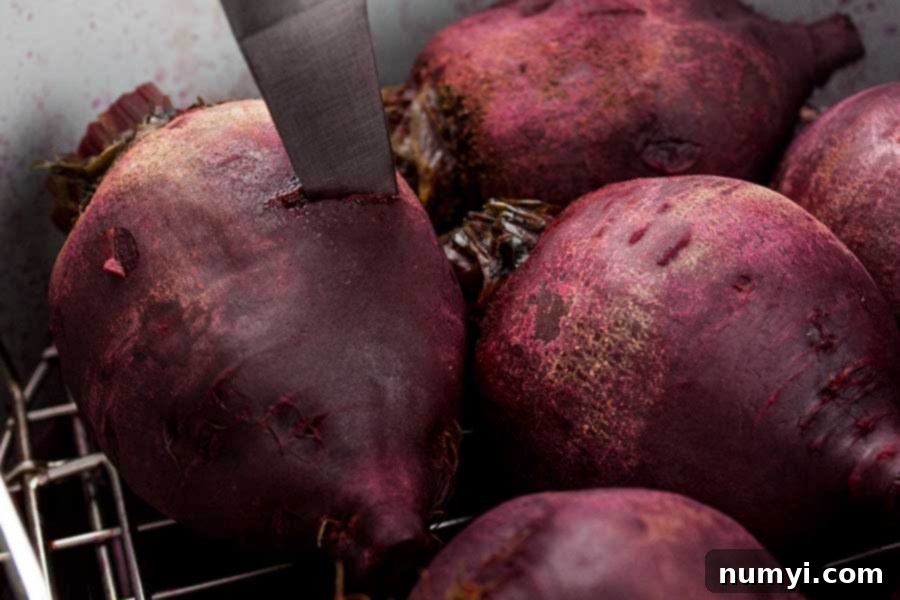
Testing for Doneness:
Once the steam has fully released and the float valve has dropped, carefully open the lid. Use a sharp knife or a fork to pierce one of the beets to test for doneness. If the knife slides into the flesh with little to no resistance, your beets are perfectly cooked and tender.
If, however, the beets still feel a bit firm for your liking, don’t worry! You can return the lid, set the valve to sealing, and cook them for an additional 2-5 minutes under high pressure. A quick release after this short extra cooking time should result in the desired tenderness.
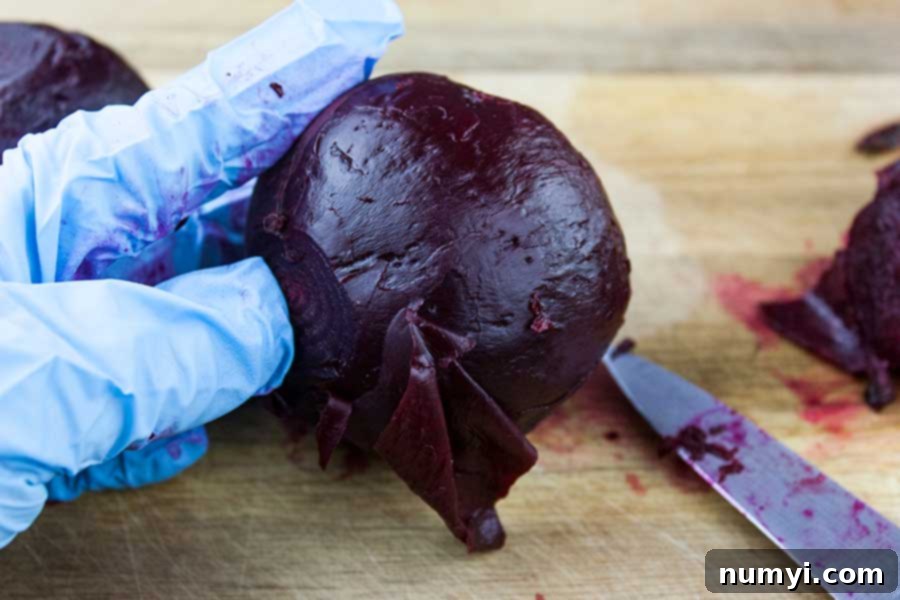
Effortless Peeling: How to Easily Remove Skins from Cooked Beets
One of the best advantages of pressure cooking beets is how simple it makes the peeling process. After they’ve cooked, the skins become much looser and easier to remove. To prevent staining your hands, I highly recommend wearing latex or rubber gloves for this task, as beet juice can leave a stubborn stain.
Once the beets are cool enough to handle comfortably, trim both ends off each beet. Then, choose your preferred peeling method:
- Hands Under Running Water: The simplest method is often to use your gloved hands. Hold a beet under cool running water and gently rub the skin. It should slip off quite easily.
- Paring Knife: For slightly more stubborn spots or for a cleaner finish, use a small paring knife to gently scrape or peel the skins away.
- Paper Towels: Wrap a paper towel around a beet and rub gently. The friction helps to loosen and remove the skin effectively, while also acting as a barrier against staining.
No matter which method you choose, you’ll find that peeling cooked beets is far less messy and time-consuming than peeling raw ones.
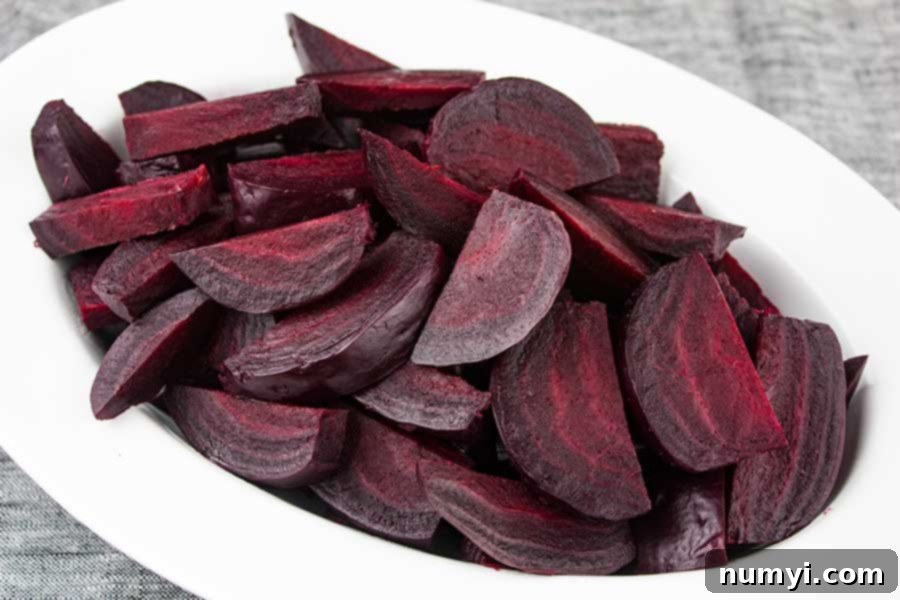
Once peeled, slice the tender, vibrant beets, arrange them on a platter, and get ready to relish the incredible taste of truly unprocessed, perfectly cooked beets. They make an excellent side dish, can be added to salads, or even pickled for later enjoyment.
Once your pressure-cooked beets have cooled completely, place them in an airtight container and refrigerate for up to 4 days. This makes them a great option for meal prepping throughout the week. You can enjoy them cold in salads or quickly reheat them for a warm side.
Absolutely! This recipe is completely interchangeable between the Ninja Foodi and the Instant Pot. The cooking times and preparation steps remain the same. Simply follow your Instant Pot’s manual instructions for pressure cooking to achieve the same delicious, tender beets.
More Delicious Pressure Cooker & Slow Cooker Recipes
If you’re loving the convenience and flavor of pressure cooking and slow cooking, be sure to check out these other fantastic recipes:
- Slow Cooker Boston Baked Beans: A classic comfort food, perfectly cooked to tender perfection.
- Ninja Foodi Mexican Pinto Beans (Charro Beans): Flavorful and hearty, these beans are a staple for any Mexican-inspired meal.
- Slow Cooker Lentil Soup Recipe: A healthy and warming soup, ideal for a cozy evening.
- Slow Cooker Beef Stew: Tender beef and vegetables simmered to create a rich and satisfying meal.
These recipes highlight how versatile your kitchen appliances can be, making healthy and delicious meals a breeze!

Ninja Foodi Pressure Cooker Fresh Beets Recipe
Print
Pin
Rate
Ingredients
- 6 beets medium, about 3 inches in diameter
- 1 1/2 cups water
- Kosher salt optional, to taste
- black pepper freshly ground, optional, to taste
Instructions
-
Trim the beets, leaving about 1/2-inch of the stem and roots attached. This helps in easier peeling after cooking and minimizes color bleeding. Thoroughly wash and scrub the beets to remove any dirt.
-
Place the rack (or trivet) in your pressure cooker pot. Pour in 1 1/2 cups of water. Carefully lay the prepared beets in a single layer on the rack, ensuring they are not submerged in water.
-
Secure the pressure cooking lid in place and lock it. Make sure the pressure release valve is set to the “Sealing” position.
-
Set your pressure cooker to high pressure and cook for 30 minutes (for 3-inch beets). Press start if your model requires it.
-
When the cooking cycle finishes and the timer beeps, turn off the appliance. Carefully perform a manual quick release (QR) by turning the pressure release control to “Venting.” Allow all steam to escape before opening the lid.
-
Use a sharp knife to pierce the beets to test for doneness. If the knife slides into the flesh without much resistance, they are done. If the beets seem a little too firm, you can cook them for another 2-5 minutes under high pressure.
-
Let the beets cool enough to handle comfortably. For best results and to avoid staining, wear latex or rubber gloves. Once cooled, trim both ends off the beet. The skins should then easily slip off using your hands under running water, a paring knife, or a paper towel.
-
Slice the peeled beets as desired, season with optional salt and freshly ground black pepper to taste, and serve immediately. Enjoy your tender, flavorful pressure-cooked beets!
Notes
- 1″-2″ in diameter: 10-15 minutes high pressure
- 2″-3″ in diameter: 15-20 minutes high pressure
- 3″ or larger in diameter: 25-30 minutes high pressure
Please remember that nutrition facts are estimates and will vary based on the specific ingredients and brands you use. We strive to provide the most accurate nutritional information possible, but we encourage you to calculate for yourself if precise figures are needed.
Nutrition
